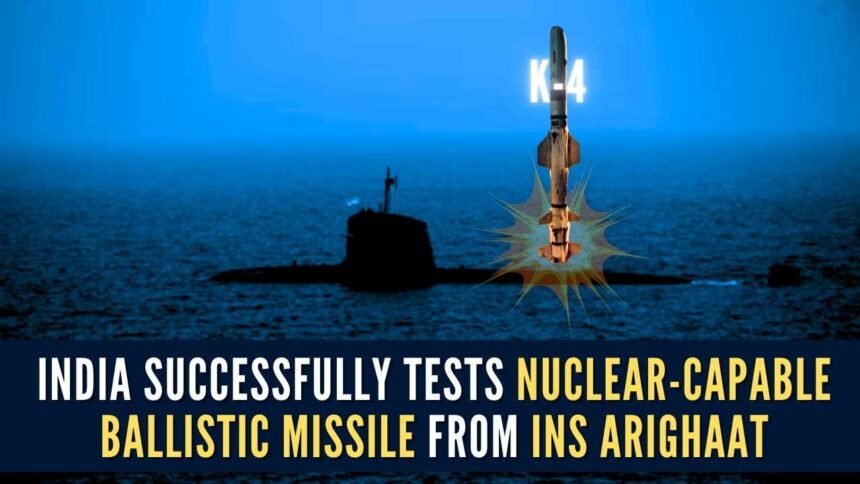The Big News: A Game-Changer in Strategic Defense
On November 28, 2024, the Indian Navy carried out the test-firing of the K-4 nuclear ballistic missile, which has an impressive range of 3,500 kilometers. This missile was launched from the newly commissioned nuclear submarine INS Arighaat. The event underscores India’s commitment to enhancing its military might, ensuring the security of its borders, and maintaining peace through strategic deterrence.
What is the K-4 Missile?
The K-4 nuclear ballistic missile is a state-of-the-art weapon design India’s Defence Research and Development Organisation (DRDO). Here are some key features:
- Range: 3,500 km, enabling long-distance strike capabilities.
- Purpose: Part of India’s second-strike capability, ensuring retaliation in the event of a nuclear attack.
- Launch Platform: Can launch from underwater submarines, offering stealth and mobility advantages.
The Role of INS Arighaat in the Test
INS Arighaat, commissioned into service on August 29, 2024, played a pivotal role in this landmark test. Aptly named the “destroyer of the enemy,” this nuclear-powered submarine is equipped with advanced technology that allows it to fire missiles like the K-4 with precision.
Why Is This Test Significant?
- Boosts Second-Strike Capability: The test validates India’s ability to respond to nuclear aggression, ensuring a robust defense mechanism.
- Technological Achievement: Demonstrates the successful integration of underwater missile systems with nuclear-powered submarines.
- Strengthens Naval Power: The Indian Navy now has two operational nuclear submarines capable of deploying ballistic missiles—the INS Arihant and the INS Arighaat.
Inside India’s Nuclear Submarine Fleet
India’s nuclear submarine program has steadily advanced, with INS Arighaat and INS Arihant leading the charge. Here’s a quick overview:
- INS Arihant: India’s first nuclear submarine, inducted in 2016, capable of firing both K-4 and K-15 missiles.
- INS Arighaat: The latest addition, featuring improved stealth, better endurance, and advanced weapons systems.
- Future Additions: A third nuclear submarine is under construction and expected to join the fleet next year.
The Role of DRDO in Missile Development
The DRDO has been instrumental in developing and testing the K-4 nuclear ballistic missile. Before this full-range test, extensive trials were conducted using underwater platforms to ensure the missile’s reliability and performance.
Strategic Implications for India
With the successful test of the K-4 missile, India strengthens its position as a regional power with credible nuclear deterrence. This capability not only protects the nation but also promotes stability in the region by deterring potential adversaries.
A Closer Look at Second-Strike Capability
Second-strike capability is crucial for maintaining a balance of power in nuclear diplomacy. It ensures that even if an adversary launches a nuclear attack, India retains the ability to retaliate, effectively discouraging any initial aggression. Submarine-launch missiles like the K-4 are vital to this strategy because they can deploy covertly, making them harder to detect and neutralize.
What’s Next? More Tests on the Horizon
Defense sources indicate that the Indian Navy plans to conduct additional tests of the K-4 system. These trials will further validate its operational readiness and integration with submarines like INS Arighaat.
India’s Journey to a Self-Reliant Defense
The development and successful testing of the K-4 nuclear ballistic missile is a testament to India’s commitment to self-reliance in defense. It showcases the country’s ability to design, develop, and deploy advanced military technologies independently.
Read More: Explosion Near PVR in Prashant Vihar, Delhi: What Happened?
Conclusion
The successful test of the K-4 nuclear ballistic missile from INS Arighaat is a landmark achievement for India’s defense capabilities. It sends a strong message about India’s technological prowess and its commitment to safeguarding national security. As the nation continues to strengthen its strategic defense systems, it reinforces its position as a global power ready to ensure peace and stability.










